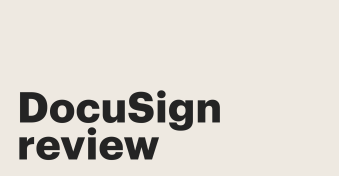Ensuring a strong e-signature workflow is an essential aspect of any modern document process. To do this well, companies typically need to partner with a digital signing platform for security and compliance.
DocuSign is often considered the industry leader in this space, but it’s not the best fit for most businesses.
Between high costs, a narrow use case, stingy transaction limits, and other factors, getting documents signed can be a major challenge.
That’s where SignRequest comes in.
In 2014, SignRequest launched from the Netherlands with the mission to transform e-signatures from a high-priced solution to an affordable tool that everyone could use.
Years later, they’re still going strong.
But how does SignRequest compare to DocuSign?
Let’s take a closer look.
Key takeaways
- DocuSign offers a broad selection of features and great scalability at some of the highest costs on the market.
- SignRequest keeps costs low, but its feature set and support options are more limited.
- Both platforms offer the same essential features, including secure audit trails, document prep tools, and a clear signing workflow.
SignRequest
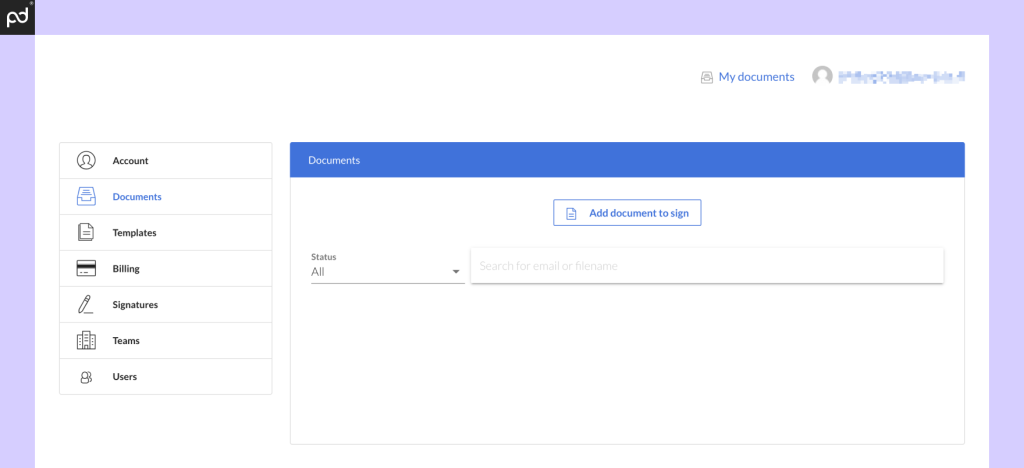
Pricing: Professional (€9); Business (€15).
Ease of use: 9.2/10
Free trial: Yes; 14 days.
Support: Knowledge base; support tickets; phone.
As an e-signing tool, SignRequest has positioned itself as an affordable contrast to dominant players in the space.
The platform offers a great selection of features in a simple streamlined format, so users will have all the tools required to capture signatures with ease.
The balance of cost and features make it a good fit for individuals and small- to medium-sized businesses who need a strong signing solution but want to keep overhead low.
The exchange for this simplicity and affordability is a lack of complexity around workflows and configurations.
For example: Although the SignRequest website is optimized for mobile, it doesn’t maintain a dedicated app for iPads or smartphones.
Power users — especially those interested in building more sophisticated signing processes — may find SignRequest’s toolkit lacking.
That’s especially true when compared to market competitors that can offer scalability to the enterprise level.
DocuSign
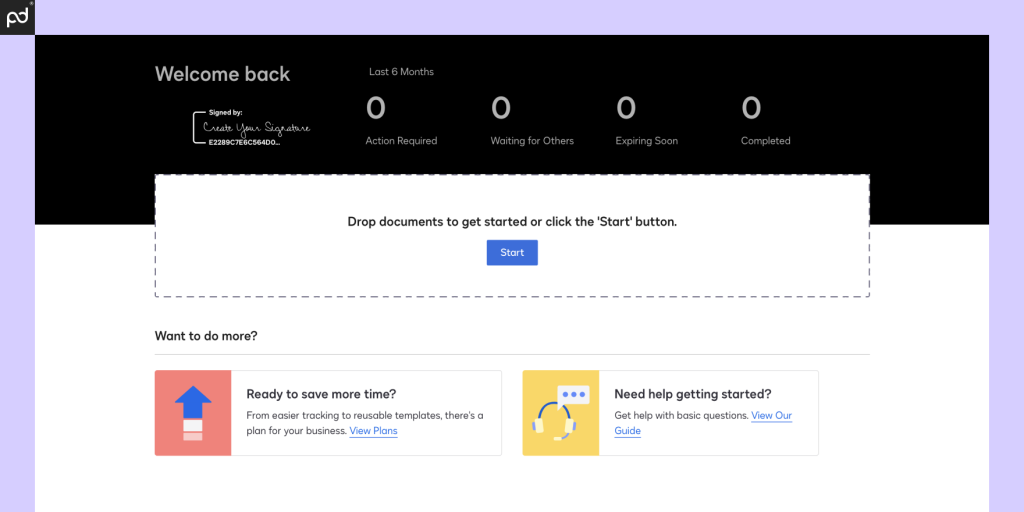
Pricing: Personal ($15); Standard ($45); Business Pro ($60). Enterprise pricing available. All pricing based on month-to-month commitment.
Ease of use: 9.0/10
Free trial: Yes; 30 days.
Support: Knowledge base; support tickets; additional support plans sold as separate packages.
As a major player in the e-signing space, DocuSign offers a comprehensive and reliable solution for businesses of all sizes.
The platform is robust, boasts a wide array of features around electronic signature capture and document management.
DocuSign’s core strength lies in scalability, security, and compliance.
The platform is large enough to offer digital signature solutions at the enterprise level, including customization options around enterprise plans and customer support.
It’s even possible for individual entities, such as real estate agents, to utilize plans under the umbrella of larger organizations, like the National Association of Realtors (NAR).
While the platform’s e-signature tool uses a deceptively simple drag-and-drop interface, DocuSign’s ability to integrate seamlessly with niche software platforms make it a logical choice as a service provider for many organizations.
Unfortunately, all of DocuSign’s products come with hefty costs and strict transaction limits. Advanced solutions around document management are separate from its e-signature software. The DocuSign ecosystem is vast (and growing), but expect to incur hefty costs if you intend to leverage that power for your organization.
SignRequest vs DocuSign at a glance
While both DocuSign and SignRequest have plenty of basic features in common, they differ in a few critical areas.
Here’s a closer look at the top plans offered by both platforms.
| Plan Details | DocuSign | SignRequest |
|---|---|---|
| Plan Name | Business Pro | Business |
| Core product | ||
| E-signature capture | ✓ | ✓ |
| Real-time audit trail | ✓ | ✓ |
| Notifications | ✓ | ✓ |
| Language support | ✓ | ✓ |
| Mobile app | ✓ | X |
| Reporting tools | ✓ | X |
| E-signing features | ||
| Signing order | ✓ | ✓ |
| Send to multiple recipients | ✓ | ✓ |
| Bulk send | ✓ | $ |
| In-person signing | ✓ | ✓ |
| Collaboration tools | ✓ | X |
| Signer attachments | ✓ | ✓ |
| Payment gateway | ✓ | X |
| Document prep | ||
| Drag & drop fields (PDF) | ✓ | ✓ |
| Create reusable templates | ✓ | 5 |
| From-scratch document builder | X | X |
| Pre-built template library | X | X |
| Form creation | ✓ | X |
| Custom branding | ✓ | ✓ |
| Integrations & API | ||
| Import & storage | ✓ | ✓ |
| CRM | X | X |
| Productivity | ✓ | ✓ |
| API | $ | $ |
| Support | ||
| Email / ticketing support | ✓ | ✓ |
| Chat support | X | X |
| Knowledge base | ✓ | ✓ |
| Phone | X | X |
| Premium support options | $ | X |
For this chart, we’ve compared the DocuSign Business Pro plan to the SignRequest Business plan to provide clear insight into platform functionality.
However, keep in mind that the price of the DocuSign plan is more than twice the cost of the SignRequest plan.
At the same time, SignRequest has no additional tier or feature set. If the feature isn’t available on the Business plan, it’s likely not available within SignRequest.
One final aspect to consider is transaction limits.
- DocuSign limits users to 100 envelopes per user/year.
- SignRequest limits transactions based on average volume.
Roughly speaking, “envelopes” and transactions are the same. When an e-signature request is initiated, the process will consume an envelope/transaction to send your document (or documents, if bundled) to your intended group of recipients.
Most platforms, including DocuSign, consume envelopes when the document(s) are sent, regardless of whether they are ever signed.
Particularly for high-volume senders, keeping an eye on those limits is essential when trying to avoid overages.
SignRequest and a few other platforms don’t have a set send limit and instead determine volume based on an unknown set of average usage.
These platforms monitor all average sends companywide and — if your usage is above average — restrict your transaction capacity or prompt you to purchase an additional business package. However, on average, this “soft cap” approach to restrictions is cheaper and more flexible than the hard cap offered by DocuSign.
Quick note: PandaDoc and a few other platforms don’t have set usage caps. If transaction limits of any kind are an obstacle for you (common for high volume senders), other options are available.
Requirements, workflows & pricing
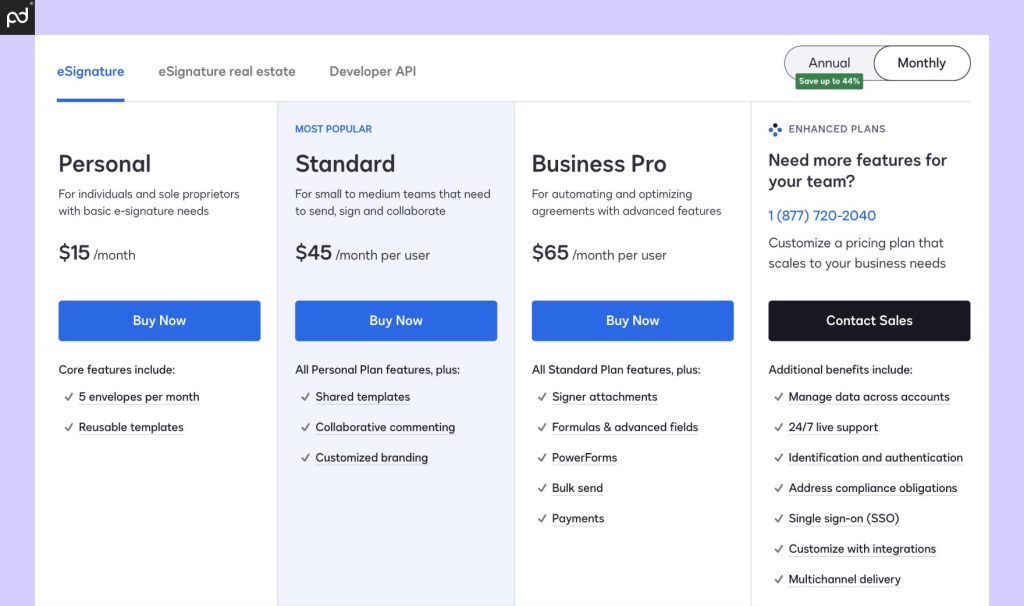
Both DocuSign and SignRequest serve a similar function inside the modern document workflow. These platforms exist to help users more easily sign documents, and both options provide a similar toolkit.
Put another way: You’ll only need one or the other (or a platform that provides a similar function).
Both platforms will require you to upload a completed document, typically created in a third-party program like Microsoft Word, before using the on-platform, drag-and-drop tools to prepare the document for e-signing.
This is typical for most SaaS-based e-signing platforms, although a few allow for from-scratch document creation completely inside the interface.
Once you’ve uploaded your documents and added the appropriate signature fields, you’ll dispatch files via the platform to intended recipients.
Signers will follow the sent links back to the document, which captures their IP address and signing location (no account creation required), to use as a valid form of identity verification.
After all signatures are complete, the document is finalized, and a copy is delivered to all parties.
This workflow is largely the same within both SignRequest and DocuSign.
The greatest difference between them is cost.
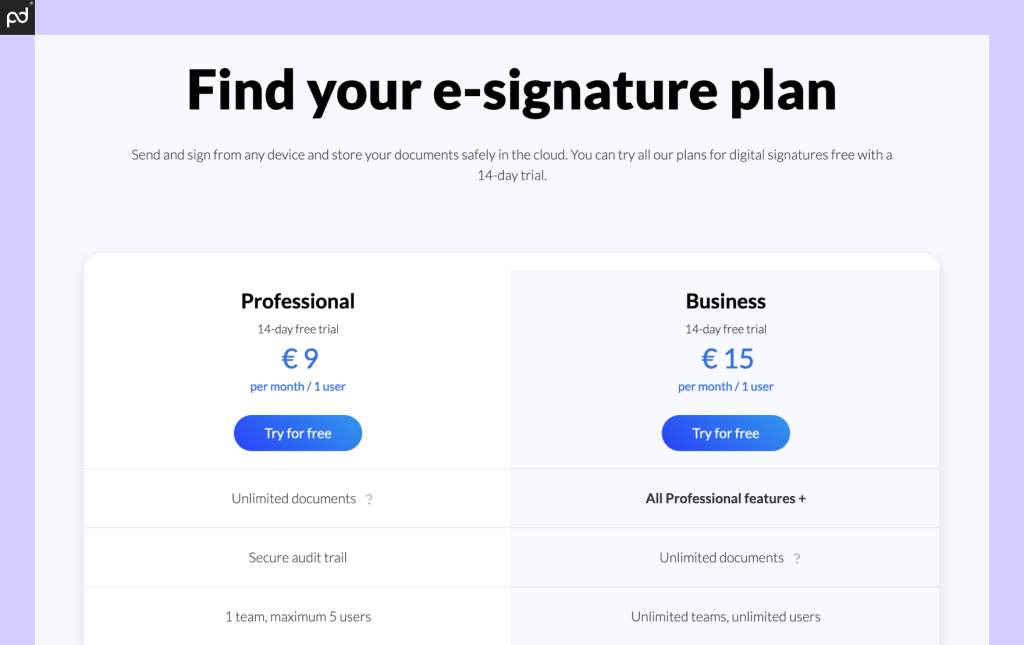
While there are plenty of DocuSign competitors out there (trust us, we’ve covered plenty of them), SignRequest is easily one of the most cost effective alternatives on the market today.
Though it lacks many of the extra features provided by DocuSign, it’s available for a fraction of the cost and without the usage restrictions that frustrate many DocuSign users.
When comparing purely by price, DocuSign’s mid-tier Standard plan ($20 month / annual commitment) is still more expensive than SignRequest’s top-tier plan and adheres to stricter usage caps.
However, in exchange for higher costs, DocuSign offers a greater level of scalability and support that will be ideal for large / enterprise organizations who need signing solutions for dozens of teams or thousands of users.
Our suggestion
Overall, SignRequest occupies an interesting position in the e-signing niche, as their goal has always been to push for more affordable and user-friendly e-signing solutions.
This is reflected in their cost and, to a degree, in their e-signing experience (more on this below).
While SignRequest won’t be a great fit for larger organizations or those with very specific integration needs, small businesses with a limited budget and a growing need for e-signature tools will feel right at home here.
- DocuSign is the better choice for enterprise teams. This platform can provide a scalable workflow for organizations of any size, scope, or industry.
- SignRequest is a great alternative for small businesses and teams on a budget. While it lacks some integration options and advanced features, the platform provides a solid e-signing solution at an affordable rate.
- PandaDoc, GetAccept, and Proposify are all good options if you want to consolidate your document creation and e-signing processes into a single, seamless workflow.
E-signing experience
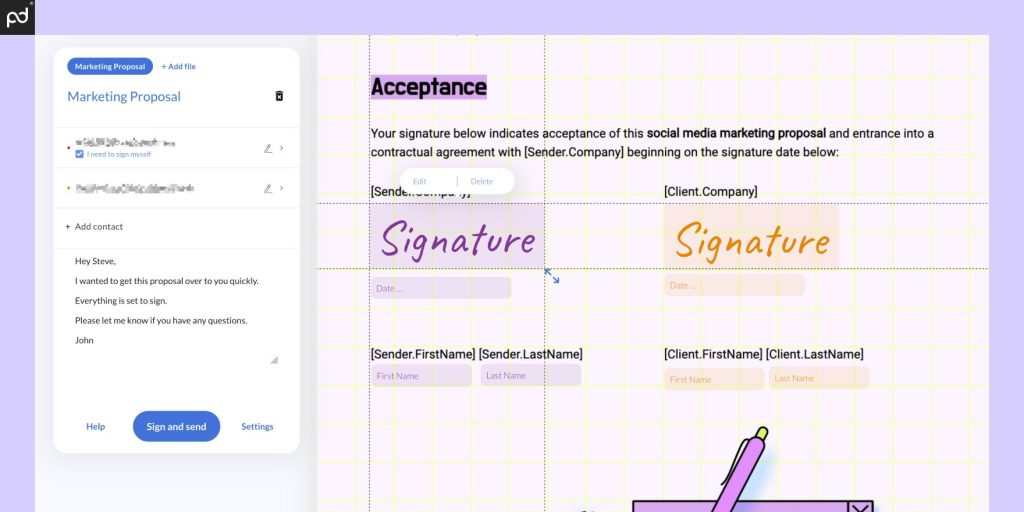
The electronic signatures created by both DocuSign and SignRequest require similar information and rely on the same, basic toolkit.
However, both organizations take a different approach to document preparation and the signature capture process.
SignRequest offers one of the most compact e-signing experiences around. You’ll handle document preparation, signer selection, outreach, and the majority of the sending process all on the same page.
The left-hand window allows users to list intended recipients and draft outreach emails while the majority of document preparation takes place on the right-hand side.
Like most platforms, SignRequest provides a handful of drag-and-drop tools in addition to electronic signature boxes and allows for minor document modifications.
This is different from the full-blown customization features in the PandaDoc document editor, but users can make small changes to text, add dates, and or request initials and signoffs.
Once preparation is complete, sending the document requires a single click and can be accomplished without ever leaving the screen.
From the recipient side, signers will receive an email with an invitation to sign.
The SignRequest website is optimized for mobile (no Android/iOS apps), so users on all devices will access the platform via the browser to initiate the signing process.
Once the signing process is complete, documents will be stored in the user’s account via the document management system.
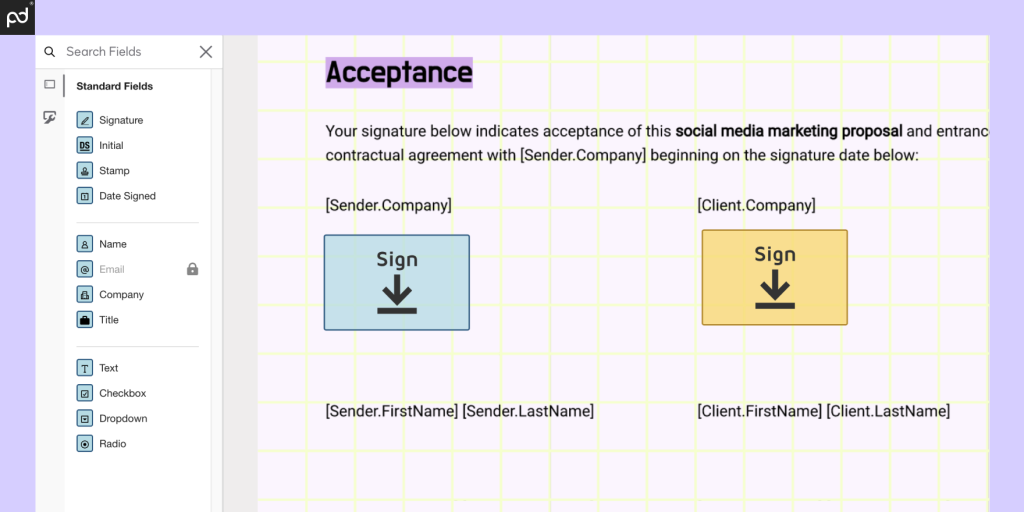
By comparison, DocuSign follows a similar process but breaks everything into multiple screens and varying stages.
Users will first upload a document via the DocuSign user interface. The next screen allows users to add signers, designate signing orders, and customize document particulars. Once these parameters are set, users will move onto the document preparation interface.
While this approach feels elongated and less streamlined, it’s more functional at scale.
SignRequest’s approach works well when a document only needs a limited amount of signatures. By contrast, DocuSign dedicates an entire stage of the process to signer selection, which allows the document preparation interface to more easily accommodate field assignments between multiple users.
Aside from a few graphical differences, the document preparation process is similar between DocuSign and SignRequest.
Once field placement is complete, DocuSign takes users to a final confirmation screen before the documents are sent and envelopes are consumed.
From the signer’s perspective, DocuSign delivers an email to the inbox. Signers can follow it to e-sign the document.
This process can also be handled via mobile apps, which senders can also use to monitor document processes.
When the document is complete, everyone receives a copy, and the master document lands in the sender’s file management system on the DocuSign backend.
Our suggestion
We’ve looked at both e-signing processes carefully, and the similarities between the two are notable.
Especially when preparing documents for a single (or small handful) of signers, both platforms offer similar performance.
Aesthetically, we prefer SignRequest’s field placement system over DocuSign. In the images above, you’ll notice that SignRequest offers very clear guidelines to assist with proper placement — something that most interfaces miss.
However, DocuSign’s multi-window approach makes everything a little easier at scale, and that’s impossible to ignore.
- SignRequest relies on a single-window experience to keep document preparation and sending simple and easy. This is great if your documents are only assigned to a few recipients.
- DocuSign offers a multi-window experience that works better for large groups of signers. At scale, this separation helps to keep the preparation process organized.
- Both platforms ultimately offer similar tools and produce similar results.
Integrations & connectors
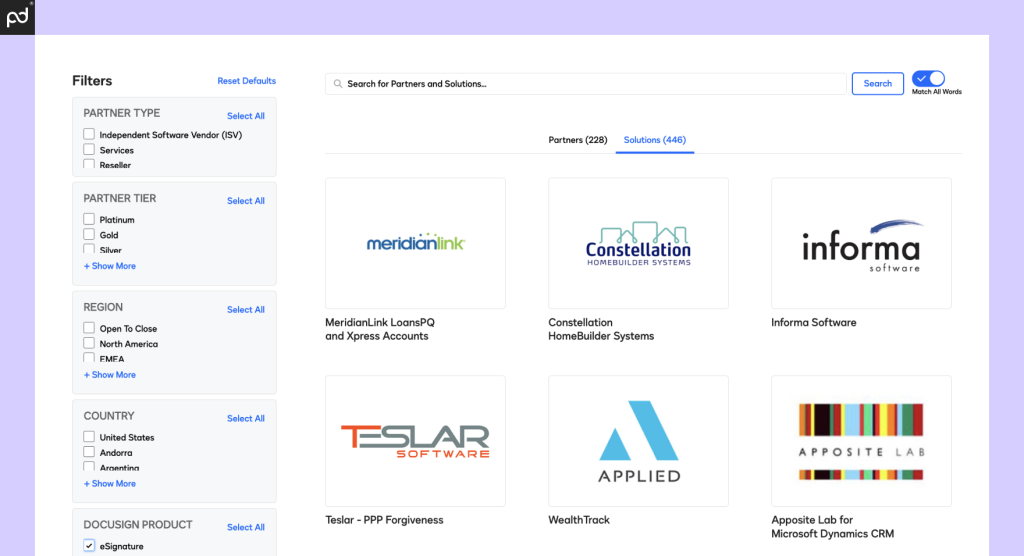
The ability to connect your signing process to the rest of an organizational tech stack is essential for businesses who need to streamline their sales and commitment process.
Automation through integration allows users to keep their existing, customizable processes in place while connecting to a signing tool in order to capture legally binding e-signatures.
DocuSign shines in this area, providing hundreds of integration options for sales platforms and contract systems across a huge selection of niche software platforms.
Using DocuSign, companies can continue to build docs with their standard toolkit and simply export to DocuSign for preparation, setup, and signing.
The majority of these integration options are available to all plans, which allows for DocuSign users to connect with essential software regardless of their service level.
However, this comes with a major caveat.
While the majority of DocuSign’s integration options are free, connections with widely used CRM and ERP systems like Salesforce, Microsoft Dynamics, and Netsuite are locked behind enterprise-only plans.
Teams who are relying on those tools will need to pay more in order to hand information and data between DocuSign and their customer platform.
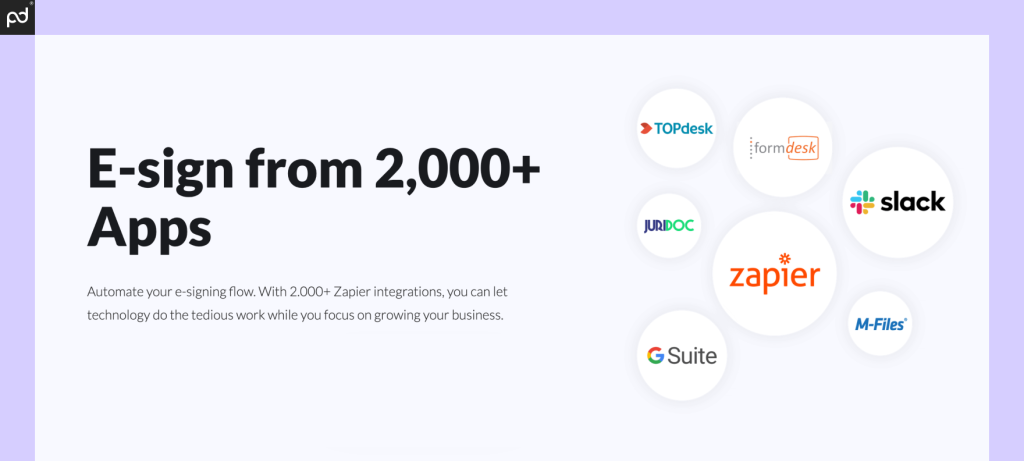
Unfortunately, SignRequest doesn’t have any better solutions in this regard. The company only offers a few native integrations, including connections with Google Workspace (Docs, Sheets, Gmail, etc.), Slack, and other software options.
Instead, SignRequest users will find most integration options handled through Zapier, a third-party connection solution that automatically allows SignRequest to integrate with thousands of other apps.
While Zapier can be useful, utilizing its trigger/action system between apps (called zaps) will incur additional operating costs paid to Zapier.
Overall, this is a great option for users who need to connect to any of the 6,000+ app available on Zapier, however the integrations are native and some users will find this functionality limiting.
Our suggestion
If you’re looking for native connectivity between your e-signing platform and another tool in your tech stack, DocuSign will be hard to beat.
The platform offers a vast selection of integration options when compared to SignRequest (and most other apps), often for very niche / specific industry software.
SignRequest still offers connectivity through Zapier, and we don’t expect that to change anytime soon.
Some of the company’s integrations (such as its Salesforce integration) have depreciated over the years, and the company hasn’t made a move to introduce or restore them.
- DocuSign offers a better integration selection than most other apps, but their plans are also higher than most competitors.
- SignRequest relies primarily on Zapier for its integrations. Although this platform will cost extra to use, SignRequest’s low price may offset these costs..
- PandaDoc offers Zapier connections and native integrations with leading CRMs, productivity tools, and ERP systems.
Security & compliance
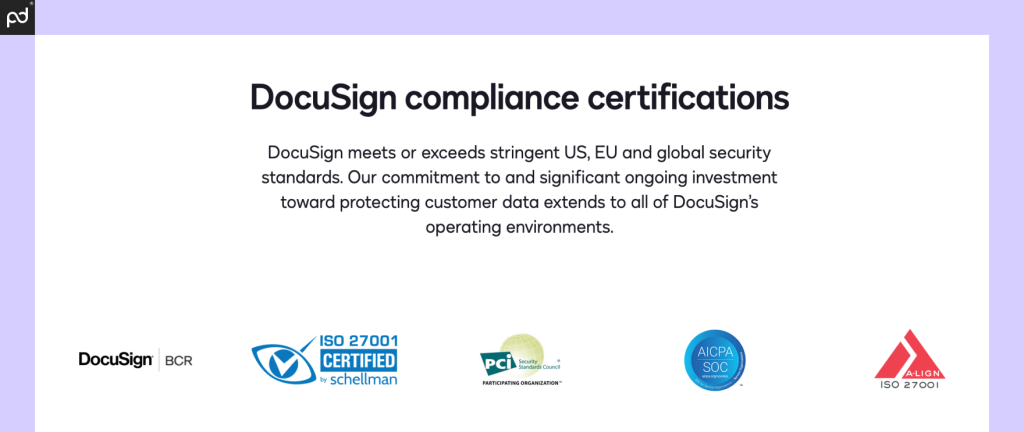
Ensuring that digital signatures are authentic and compliant is essential when choosing an e-signing platform.
Companies need to know that signers are authentic, while contracts and other sensitive information need to be kept secure during and after the signing process is complete.
In many ways, DocuSign offers the industry-standard solution for document security and legal compliance.
Like PandaDoc, this platform adheres to a wide range of security standards, including ISO 27001, SOC1 Type 2, SOC 2 Type 2, and PCI DSS. It also offers GDPR compliance and can act as a trusted partner under HIPAA (enterprise only).
The company also offers data residency options to help users ensure that key data is kept in US, EU, or AS regions.
Enterprise accounts can talk to the sales team about further restricting data to a specific location or facility, similar to how we do things at PandaDoc.
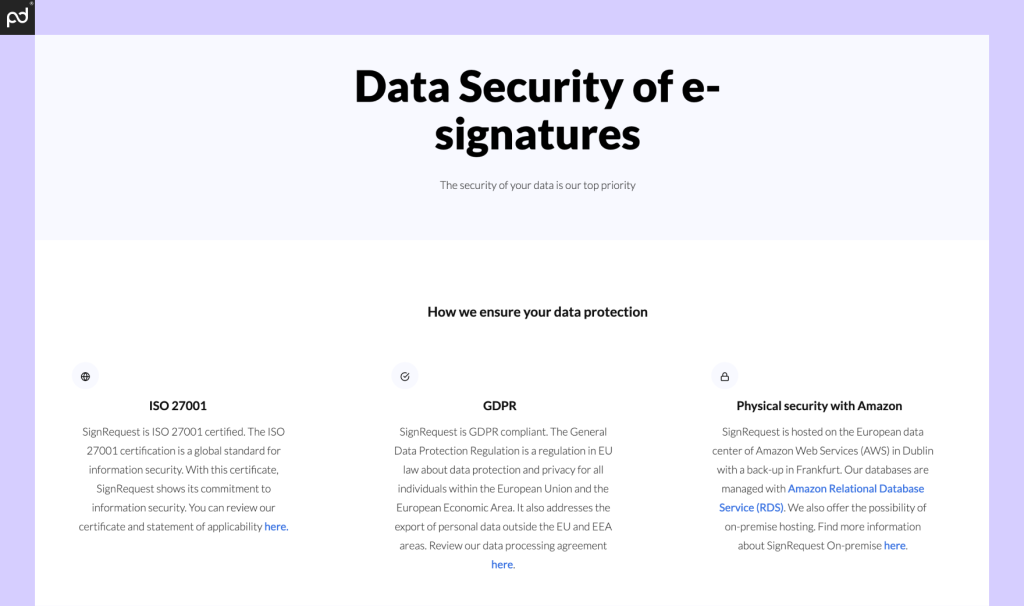
By comparison, SignRequest offers strong overall security while falling short in a few places.
Although SignRequest is fully compliant with GDPR standards, it doesn’t meet the criteria for HIPAA compliance.
This isn’t surprising, since it’s an EU-based company and HIPAA is exclusively a US-regulatory matter.
However, SignRequest maintains data residency in the EU (in Dublin and Frankfurt) by default, and maintains ISO 27001 compliance through the Amazon Web Services data centers that it utilizes.
Our suggestion
When comparing security for e-signing solutions, the best solution for you will depend on your specific needs.
For most companies, both DocuSign and SignRequest offer adequate security and compliance measures.
Between features like audit trails and IP logging, signer validation is practically in industry standard.
Compliance with ISO 27001 and GDPR also serves to ensure that data remains secure while stored on company servers.
However, your mileage may vary.
If you need a HIPAA-compliant option, DocuSign is a clear winner. However, if GDPR compliance and EU data residency is your preferred approach, SignRequest is a solid option.
- DocuSign offers a more robust collection of security features and can work with HIPAA regulations. Data residency selection options infer extra charges.
- SignRequest defaults to EU data centers and GDPR compliance, but it doesn’t work with HIPAA.
- PandaDoc offers a similar level of security compliance to DocuSign and maintains servers in both the US and EU. With an appropriately signed BAA, we also offer HIPAA compliance.
Alternatives to SignRequest & DocuSign
While SignRequest and DocuSign will both be great fits for the right user, they aren’t the only e-signing solutions available in today’s marketplace.
Several other e-signing platforms offer unique features and will cater to a variety of different budgets and needs.
Here’s a quick list:
- PandaDoc.
- DocHub.
- Dropbox Sign (formerly HelloSign).
- Acrobat Sign (formerly Adobe Sign).
- GetAccept.
If you’re not sure where to start, we’d recommend PandaDoc.
Our platform offers a huge selection of features, including from-scratch document creation, e-signature collection, powerful automation tools, and more.
We also maintain native integrations with platforms like Microsoft Word, Google Docs, Salesforce, and others, so that integrating your existing data and workflows is fast and easy.
Wrap up section
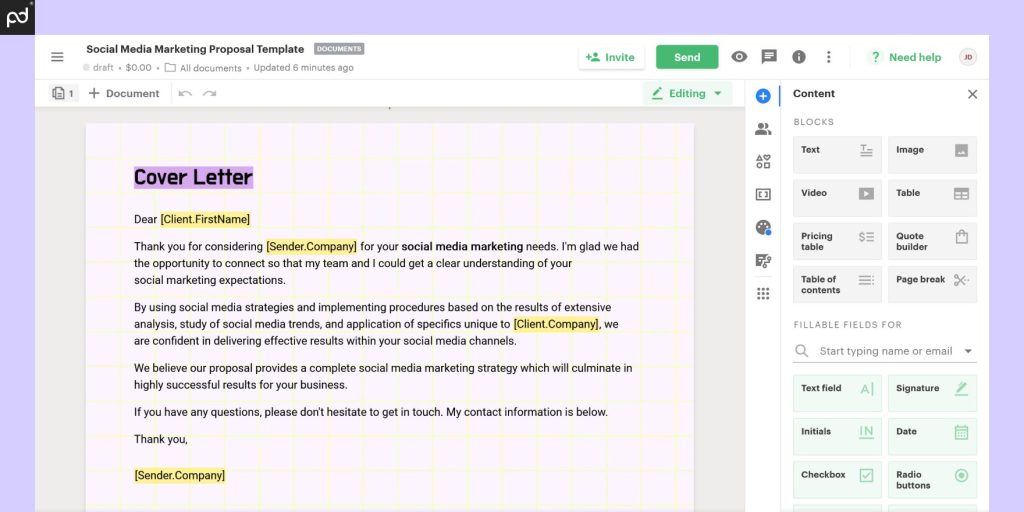
Want to go beyond simple e-signing tools like DocuSign and SignRequest?
PandaDoc is your answer.
Most e-signing tools are focused exclusively on helping users get documents signed.
PandaDoc takes that one step further by helping you consolidate your entire document creation process into a simple, seamless workflow.
Our powerful, built-in editor helps you create and customize documents effortlessly.
Our 24/7/365 chat support is always free, and phone support is available through premium support plans.
Experience the magic firsthand with a 14-day free trial or schedule a demo to see how PandaDoc can permanently upgrade your entire document workflow.
Disclaimer
Parties other than PandaDoc may provide products, services, recommendations, or views on PandaDoc’s site (“Third Party Materials”). PandaDoc is not responsible for examining or evaluating such Third Party Materials and does not provide any warranties relating to the Third Party Materials. Links to such Third Party Materials are for your convenience and do not constitute an endorsement of such Third Party Materials.
Originally published March 16, 2022 updated August 20, 2024


